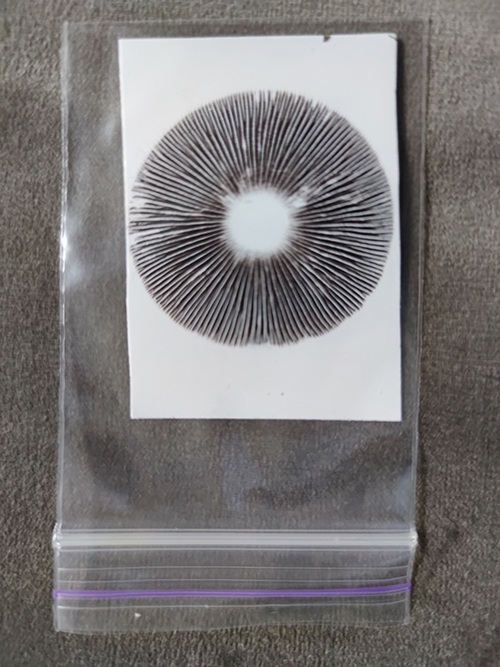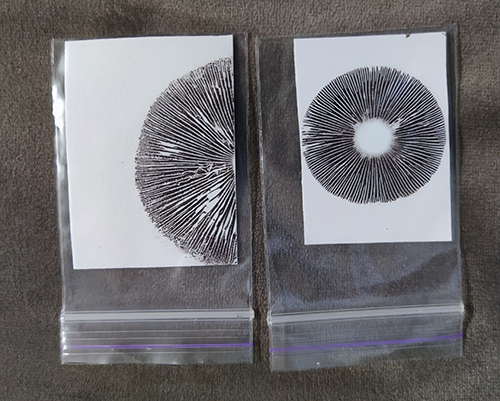What is a spore print, and what does it look like?
What is a spore print?
A spore print is a unique method of visualizing and collecting mushroom spores, widely used in mycology for identifying and studying various species, including psilocybin mushrooms. This method is based on the natural process of spore release by mature fruiting bodies and allows for obtaining a characteristic "print" of the spore pattern on a prepared surface.

The process of obtaining a spore print is relatively simple. The mature cap of the mushroom is placed on a sheet of paper or foil with the hymenium (the spore-bearing underside) facing down, and it is left for several hours, usually overnight. During this time, the spores naturally fall from the mushroom, forming a characteristic pattern on the surface.
What does a spore print look like?
The appearance of a spore print of psilocybin mushrooms has several characteristic features. A typical print resembles a radial pattern that mirrors the structure of the mushroom's hymenium. In most species of psilocybin mushrooms, this pattern consists of fine lines radiating from the center to the edges, reflecting the arrangement of the gills on the underside of the cap.
The color of the spore print is one of the key identification features. Psilocybin mushrooms typically have a dark purple or violet-brown spore color, which is reflected in the corresponding hue of the print. This shade can vary from deep dark purple to lighter lilac or even brownish, depending on the specific species and the conditions under which the print is obtained.
The texture of the spore print in psilocybin mushrooms is usually uniform and velvety. When the procedure is done correctly, the spores are evenly distributed across the surface, creating a homogeneous layer without noticeable gaps or clumps.

How to distinguish a quality spore print from a poor one?
The quality of the spore print is crucial for its further use in identification and research. There are several criteria by which the quality of the obtained sample can be assessed:
- A quality print should have a clearly distinguishable pattern that replicates the structure of the mushroom's hymenium. Blurred or unclear lines may indicate issues in obtaining the print.
- The spores should be evenly spread across the surface, without noticeable gaps or excessive clumps.
- A good psilocybin mushroom spore print should have a rich, dark color. A print that is too pale may indicate immature mushrooms or improper conditions during the sample collection.
- A quality print should not contain foreign particles, water droplets, or fragments of mushroom tissue.
- The ideal sample should reflect the full structure of the mushroom's hymenium. Partial or fragmented prints may result from using a damaged or immature cap.
The size of spore prints
It's important to note that the size of a spore print can vary even within a single species, depending on the age of the mushroom, its growth conditions, and individual genetic traits. Based on the cap diameter used for obtaining the print, the following categories are distinguished:
- Small prints (diameter up to 3 cm): It's common to place several prints on a single piece of paper. Such sizes are also typical for mushrooms with small fruiting bodies (e.g., Psilocybe tampanensis).
- Medium prints (diameter 3-5 cm): The most common size for a spore print.
- Large prints (diameter over 5 cm): When working with very large specimens, partial prints are sometimes made using only a segment of the cap, from half to a quarter.

A small spore print is not always a sign of a poor-quality sample. The key factors for a quality print remain the clarity of the pattern, even distribution of spores, color intensity, and absence of contaminants, regardless of its size.
![[``]](/wa-data/public/site/themes/kadama/img/kadama_logo.svg)




